Whitehot Magazine
October 2025
"The Best Art In The World"
"The Best Art In The World"
October 2025
Hunter or Hipster: Interview with Rebecca Morgan on 4/20 and being a rural millennial artist in the Big City
 Rebecca Morgan, Hummel Hobo Bumpkin, 2014, Oil and graphite on panel, 14” x 12”
Rebecca Morgan, Hummel Hobo Bumpkin, 2014, Oil and graphite on panel, 14” x 12”
By JOSH NILAND April 24, 2024
Using the pandemic as a means of peering into the interior-life and personal space of artists was one way for painting to assert its relevance within a culture whose common experience coping with at-home isolation might be argued as the greatest factor contributing to a new state of disconnect. This framed the Whitney Museum’s recent Biennial survey of American art and is present throughout the work of artist Rebecca Morgan. The paintings of Rebecca Morgan were last seen in the critically successful solo treatment Over the Hill last September at Asya Geisberg’s former space in Chelsea.
Morgan speaks about her practice as though it were meant to be a palliative exercise, something deeply personal - this helps address her social anxiety. Painting gives Morgan the freedom to explore radical answers to questions about feminism, beauty, America, body politics, and patriarchy in ways fans of R. Crumb or Mike Kelley will find pleasingly familiar. She first came to New York to study for a Pratt MFA and immediately found herself overwhelmed by an aggressive professional culture dominated by figures who were profoundly antithetical to the dire assortment of hillbillies, harlots, and other rural archetypes both male and female she then began setting her many alter-egos alongside, framed by a depiction of their shared Pennsylvanian idyll.
Far away from home, Morgan slowly started idealizing a return to country life that establishes a graphic transposition between the aching polarities brought on by a new reality inside the gallery system and academia. Painting, works on paper, brass figurines, and ceramics are a means of conveying what she is becoming in between. From The Smoker (2012) to Self-Portrait Flashing on FaceTime while Smokin (2021), the same relatable domestic ritual is sustained as a coping mechanism. It has of course been changed by the introduction of a more exaggerated style and the ubiquitous $15 vape pen, but relates an unwavering aversion for the costume of society to the viewer. You’ll next see her work in a forthcoming monograph from Abrams. Here, Morgan talks on the record about social cues, smoking, the new normal, and what it means to be an artist from her background in NYC in observance of the 4/20 high holiday.
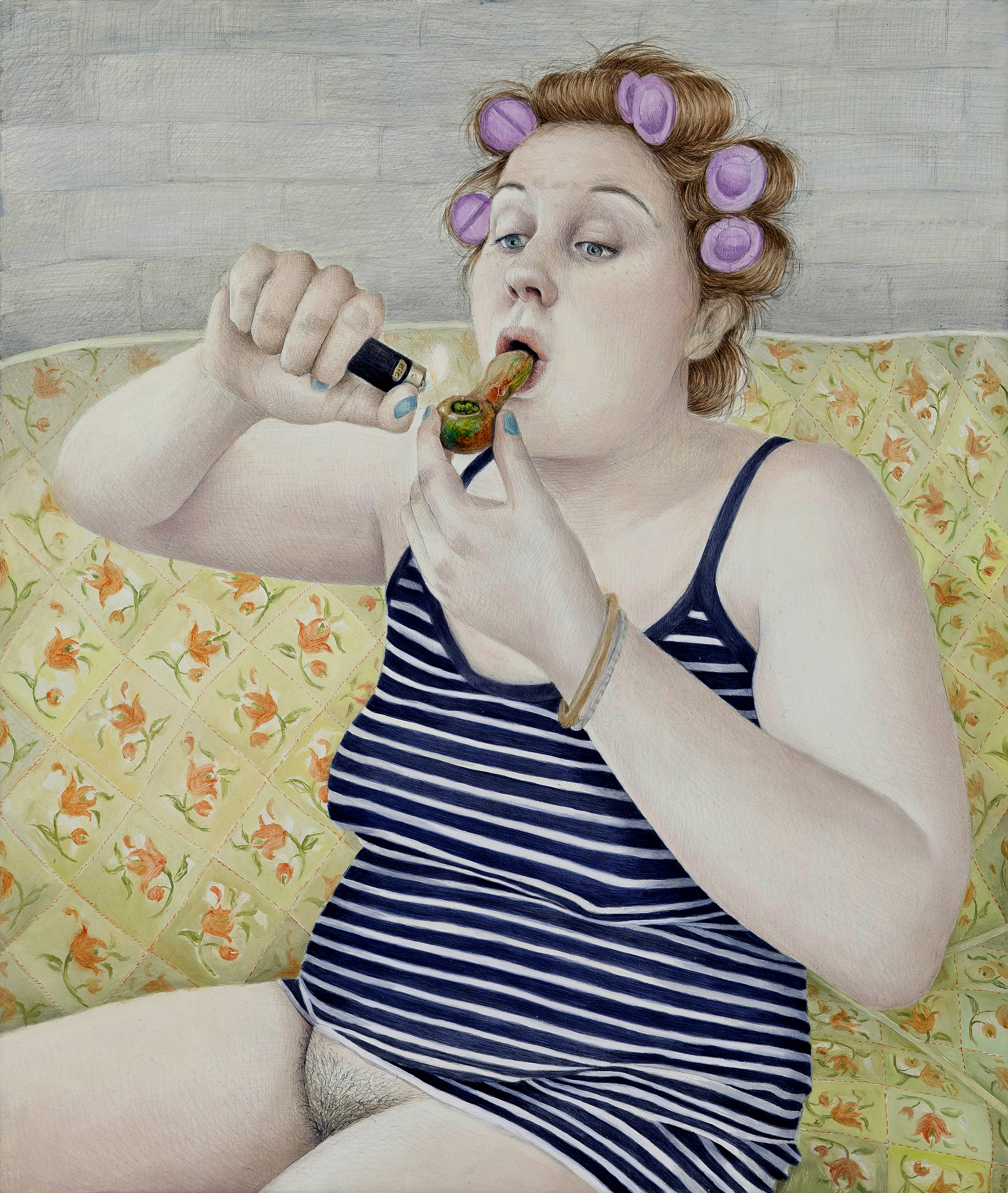 Rebecca Morgan, The Smoker, 2012, Graphite and oil on panel, 26” x 22”
Rebecca Morgan, The Smoker, 2012, Graphite and oil on panel, 26” x 22”
WM: Your work is born out of two very incongruous social strata – how often do you get the “performance anxiety” described in The Smoker? Has anything changed since you’ve become more successful in the past few years? What is it like visiting home now, is there ever discord?
RM: I often explain that one of my primary emotions is feeling “in the liminal”- straddling these two ends of the pendulum swing of the rural and urban and everything they represented. When I was in the city, I would long for the country; when I was back at home, I would wish I was in the city. I had to code switch in both places, assimilating when it was necessary, easier and safer. Being an Appalachian is in my primordial DNA- I don’t think anyone growing up in the rural couldn’t NOT navigate the world with the generational threads of it stitched into every aspect of life. Then apply that lens to navigating “the contemporary art world at large” and it really becomes cacophonous and absurd. When making art and living life, a lot of it feels like a pendulum swing of “none of this matters at all” to “this matters the very very most” and this is probably why I smoke weed the most.
The combination of being homesick and a stranger in Graduate school had me leaning into my uncomfy country mouse in the big city feelings and mining my background as a position of power, seeing that my identity was SPECIAL, important and valid. As a specialist in both the art world and the rural, I felt a duty to dispel and reject rural stereotypes while simultaneously happily claiming them and rolling around in it. I had to work through a lot of rural generational trauma and unlearn so much; filtering what was useful and rejecting what didn’t serve me. Home is 5 hours away and I go often- my aunts and uncles, granny and mom are still there. I have been profoundly lucky that as I have navigated the art world and opportunities, my mother learned alongside and always supported me- that has made ALL the difference. Being in Upstate New York the last two years does feel like a very comfortable hybrid for me; the best of all worlds in which the whiplash of the pendulum swing has been muted, but nothing has changed for me. I have always worked out of a living room on a folding table with all my stuff in plastic bins out of necessity and urgency. The last decade and a half I’ve been going from teaching job to teaching job all over the country. It was important to have an adaptable studio practice, but now I’m looking forward to settling into a sustained space and finally have my own version of HOME. This is a huge deal to me.
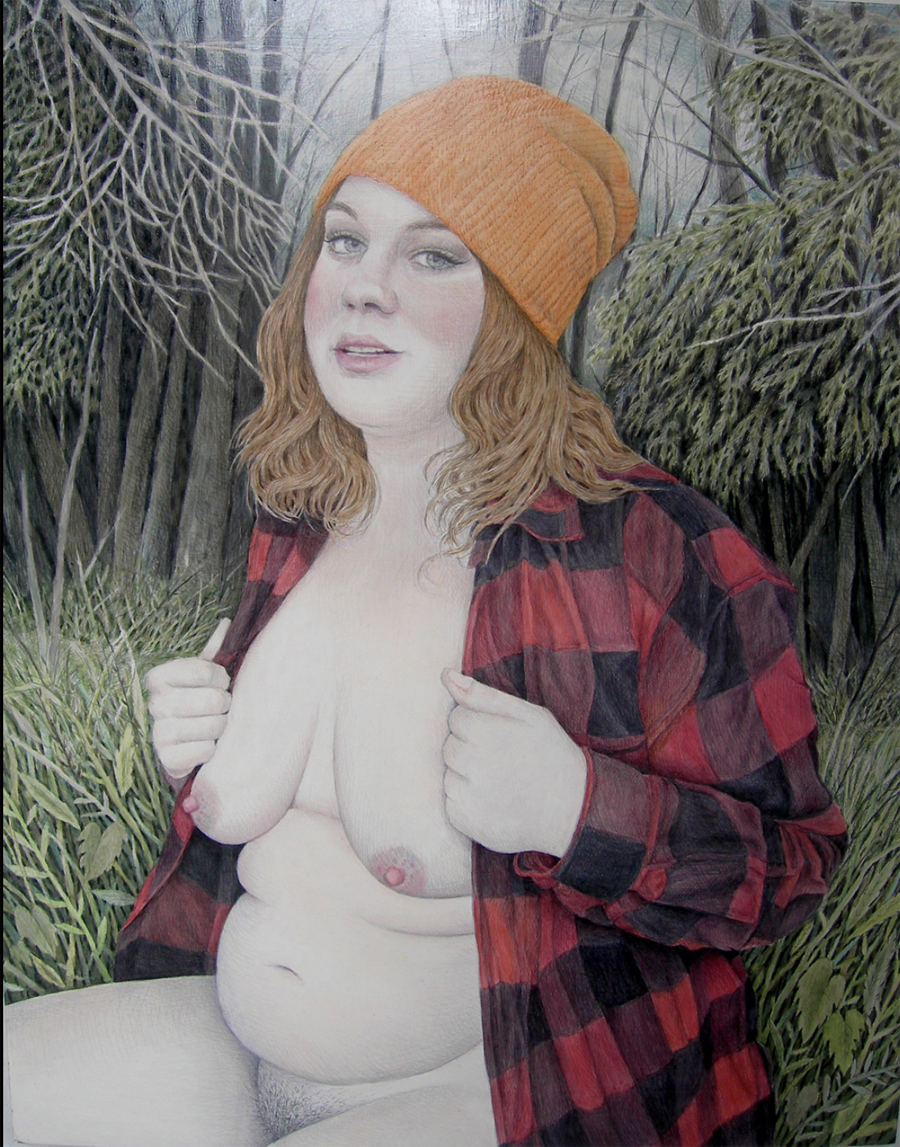 Hunter or Hipster, 2011, Oil and pencil on panel, 30 x 24"
Hunter or Hipster, 2011, Oil and pencil on panel, 30 x 24"
WM: Has your background ever led to any “awkward moments” in your time in the New York and in the art world? How have you related those experiences to your students?
RM: I went to Pratt Institute for my MFA right after graduating rural undergrad at 22 years old and ran around Brooklyn at large from 2009-2013 which in retrospect, felt like a fever dream episode of “GIRLS”- I think if you’re not looking back and cringing you did it all wrong. A huge tenant for me is embracing all the most embarrassing parts of yourself and reclaiming your power through it - capitalizing off of it. Growing up I was always dragged for having a mustache, unibrow and still have horrible teeth- those identifiers often find their way back into my figures as an attempt to reclaim and profit off of the uncomfortable shit that ultimately defined me. I urge my students to similarly mine their Rolodex of cringe.
One of the stories I tell often is upon my country mouse arrival to Brooklyn and feeling very homesick, I was urged by a lot of people to find “like-minded artist people” on Bedford Ave. in Williamsburg. Walking around I saw a familiar looking figure outside of a very cool bar- dressed in Buffalo plaid, an Orange Flair Hunting hat, beat up dirty jeans and clunky boots- donned in all the visuals that signified we were rural kin. I excitedly and earnestly interrupted and asked him where he was from, expecting the midwest or the south or hopefully, like me, the rust belt, but he replied very poshly and slightly confused that he was born and raised (and still lived) on the Upper East side. I remember asking “but what about your clothes?” and he ran me through the pieces - the boots are John Varvatos, the pants are last season Prada, the flannel Ralph Lauren....It was the first time I had seen rural signifiers cosplaying as something else entirely and rural identity co-opted “as a vibe” or aesthetic. I didn’t even know that was a feeling I could experience, but In the same spirit of turning the embarrassing moment into power, I went home and made a portrait of him and some of me called “Hunter or Hipster?” Conversely as I was making and posting these images, a lot of people assumed I was a New Yorker criticizing the rural without lived experience and that really bothered me- so it became important to me to straddle both worlds and demystify them to each other- to explain the urban to the rural and the rural to the urban with varying degrees of success.
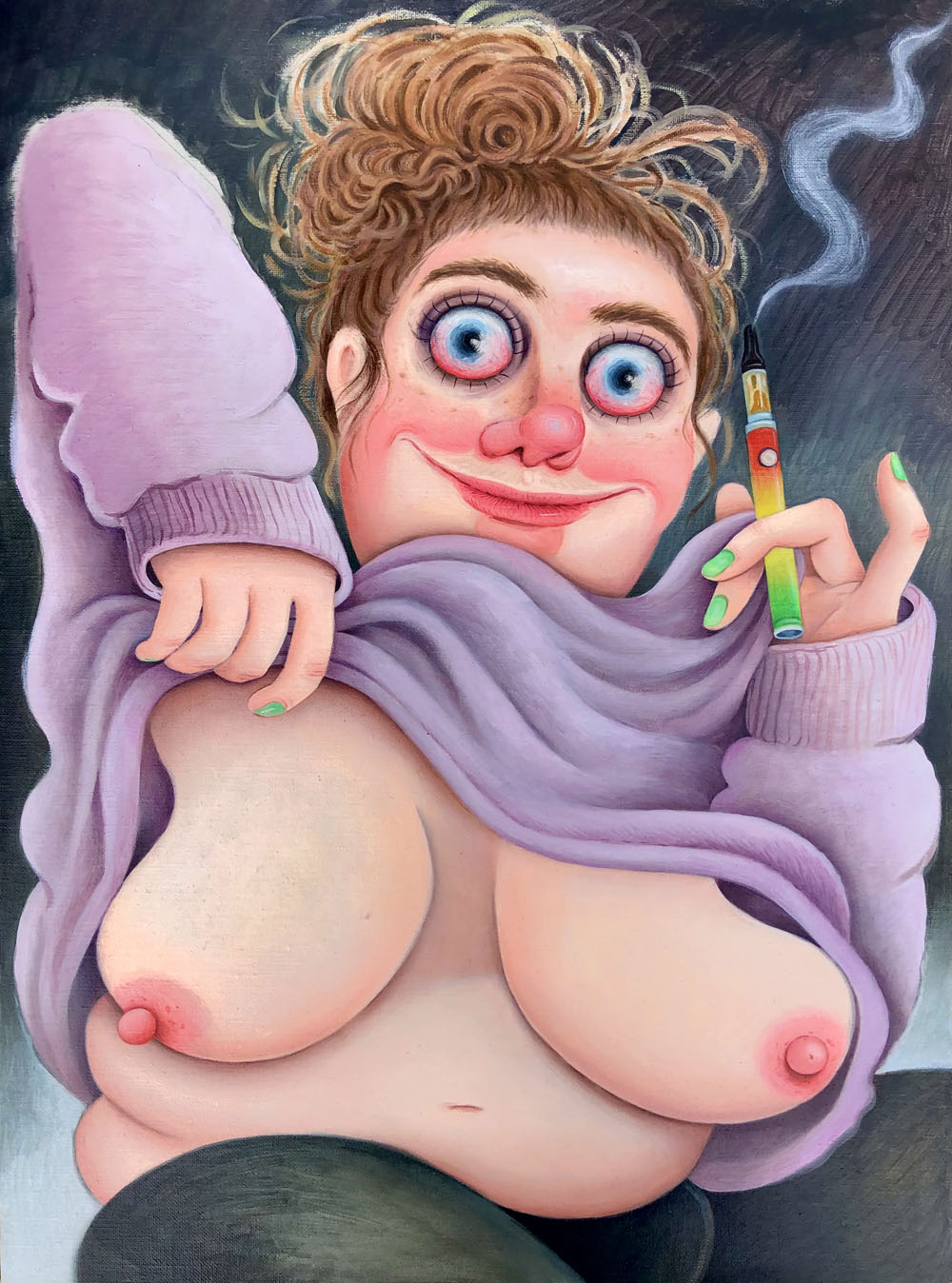 Rebecca Morgan, Flashing on FaceTime while Smoking, 2021 Oil on linen, 24h x 18w in, 60.96h x 45.72w cm
Rebecca Morgan, Flashing on FaceTime while Smoking, 2021 Oil on linen, 24h x 18w in, 60.96h x 45.72w cm
WM: That glass bowl is so achingly personal to a lot of our contemporaries’ adolescent experiences in America – how does rural post-Y2K culture inform your work? How closely do you identify with somebody like Bam Margera versus art figures like Eric Fischl or Cady Noland?
RM: My truest and primordial love is illustration/comics/cartooning; I am inspired how quickly, deeply and universally they communicate with context and nuance. For me, they dominate the equity bracket in that everyone can participate- illustration gets to the heart of the matter often unpretentiously- how comprehensively and quickly a New Yorker cover can communicate. How powerful! In straddling being a specialist and a universalist of art and images, I am undoubtedly always bowled over by the authentic and genuine “low brow”- I find it in craft, graffiti, memes, broadsides, ephemera- Skate decks! Pennsylvania Peer Bam Margera 100%. A lot of it has to do with my perceived hierarchy of the art world and accessibility. What people are able to participate in these worlds- Geographically, physically, financially, equitably? Art, art spaces and institutions are inherently privileged, gatekept, pretentious.
I think about how for better or worse, the pop culture reach of someone like y2k Bam Margera can be life-changing - the representation of an alternative figure pursuing their own aesthetics outside of the social norms. Growing up so rurally, the career path for women was nurse or caregiver, teacher, secretary, stay at home mom... I never knew being an artist or designer was something I could actually do. I didn’t have a sense that it was an achievable or valid path. As soon as someone affirmed that being a maker of things was viable and a sense of what it could look like, I felt like I had the permission to investigate it in a serious way. It took me until more than halfway through undergrad to understand that art and making could be a career, not just a talent you had or something you did when you got off of work. You could be a Bam Margera if you wanted to.
The Northern Renaissance artists like Adriaen Brouwer who I took cues from for my version of “The Smoker” really reflected some of these feelings for me as artists who had one foot in and one foot in that they were making images of agrarian, bucolic scenes, elevating the everyday and celebrating the tavern hero all while making those genre paintings for the eyes, pockets and titillation of the Bourgeoisie. Fourteen years ago when I made “The Smoker,” these themes were really central and fitting to this liminal rural and urban psychic and physical space I was straddling in my own conflicting depictions of the rural.
My self-taught folksy late grandfather was a prolific draftsman and a true outsider artist but by trade was a rural Sears Roebuck appliance salesman. I have no doubt that Tom Morgan would be able to explicate Fischl’s painting, “Bad Boy,” but it was the vehicle of ubiquitous “everyday images” - comics, illustration, cartoons- that gave him the language to decode images. Illustration and cartoons are inclusive. The shape of the universal megaphone platform they employ is as good as it gets to me- to communicate the zeitgeist and social criticism to the majority of everyday eyeballs- to sneak the medicine into the ice cream- profound. To make skate deck art that many can live with and love is profound and genuine- the truest of art to me. I think about institutions like the Art Preserve of the John Michael Kohler Arts Center whose focus is promoting and protecting the work of self-taught artists- who I feel are representative of the truest and prolific of artists who HAD to make their work at all costs- like Frank Oebser making life-sized kinetic sculptures out of barn scraps or Mary Nohl whom everything she touched she mediated and transformed. These people were COMPELLED to make things, often in a vacuum. I’m not sure I’m even wired that hardcore. Eric Fischl can talk to me when he makes a lifesized animatronic Holstein cow out of actual trash and pulleys and levers. Also, someone please let me design a skateboard.
 Rebecca Morgan, Hunter or Hispter, 2012
Rebecca Morgan, Hunter or Hispter, 2012
WM: That painting was made pretty long ago (2012). Has your social aptitude changed since then? Has it been affected at all by the pandemic?
RM: The pandemic changed it all for me- like a total breakdown. Like so many people, the pandemic brought a personal re-evaluation and forced me to slow down and confront shit. I started therapy to deal with unresolved trauma that up until 2020 I preferred to push down in order to just keep it all moving and was also diagnosed as neurodivergent. I was used to operating at such a break-neck, say ‘no’ to nothing unsustainable pace; every year for almost a decade I was moving from teaching job to residency/opportunity/gig, punctuated by long stretches at home with my mom in PA. I worked really hard in therapy- still working hard. I used to use Instagram as a public diary, dopamine drip and megaphone, but I have pulled away from it as the volume of it became really loud. As I’m more regulated and not as restless, I’m starting to come back to it and reframe it as a tool and not a reflection of my actual self. I get frustrated because I feel like I can’t go at the pace that I used to, but that pace was nuts. It all comes back to the pendulum swing- of not so much swinging for the edges, but finding a comfortable middle. Always the liminal. Post-pandemic, I’ve really turned inward, socially- the daily scope limited to what is in my immediate view- a lot of avoiding the uncomfy things and dopamine chasing. I’ll use this platform to apologize to everyone that I’ve pulled away from in the last few years- my most precious friends and crew- the volume was really really loud and I had/have to get my head right and I’m really sorry- I love you!
WM: What exactly does smoking weed do to help as a social lubricant for you?
RM: I think it helps me to dumb down the pressure of the scene- to stand a little outside of myself and be able to laugh at the absurdity and also the sweetness of it all. I’m always searching for the levity when things feel too big, too precious, too serious, too academic.... With peace and love, so much of the art world we participate in is so goofy and dumb and hilarious and I’m just very happy to be here- that is my idyllic mindset I try to claim when I’m feeling small or uncomfortable.
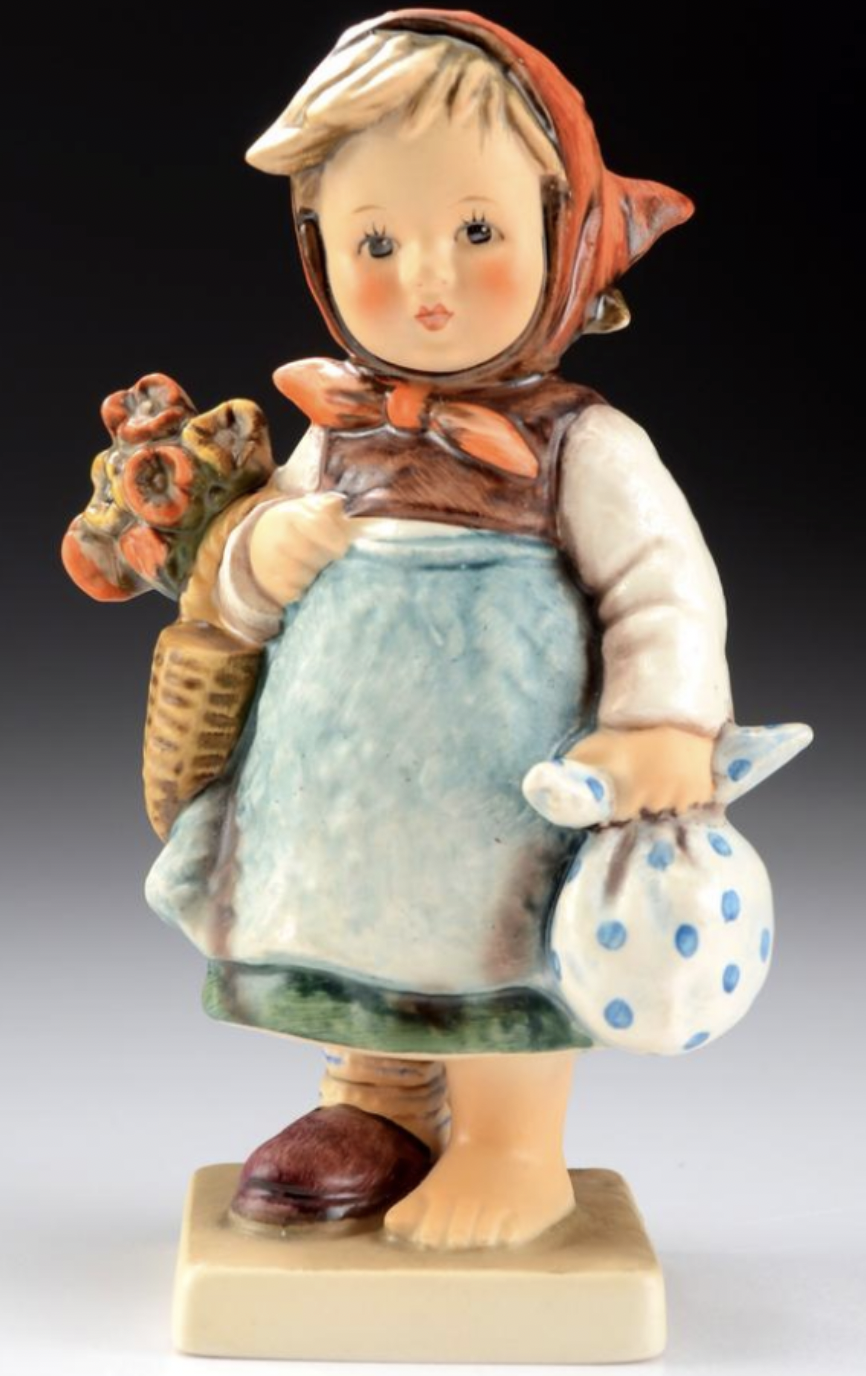 Grandmother, Hummel Figurine
Grandmother, Hummel Figurine
WM: How have you integrated ceramics into practice?
RM: Growing up so rurally, I wasn’t exposed to “fine art” very much, but I did have a lot of access to folk art and craft and more omnipresent were beloved porcelain tchotchkes of Hummel Figurines, Staffordshire and Royal Daulton rip-offs and Precious Moments. My first integration of ceramics came from stressed conversations with my late conservative grandmother who begged me to stop painting buttholes and my bare breasts and “paint something beautiful” as she gestured to her collection of Hummel Figurines.
Out of sweetness and a little spite, I made a painting of her favorite Hummel Figurine and then decided to take it further and make my own sculptural versions of the figurines which opened the floodgates for
me in expanding my formal vocabulary. Ceramics has been a way to comment on Making things three-dimensionally hit differently for me- used an entirely different part of my brain and I was grateful to have found a complimentary mode of communicating that could hit other notes than the two dimensions. Working in clay was a big permission giver to me-it helped me think more widely as an “artist” and not just a “painter” or draftsman. I haven’t had access to a ceramic studio for prolonged making in a while but I am kicking that part of my practice up again soon- making busts that reference antiquity- Hellenistic Greek busts, baroque narratives and neo-classical sculptural tropes in my own vernacular. Of course, it’s a right of passage to make a bong and I have and plan to make lots more.
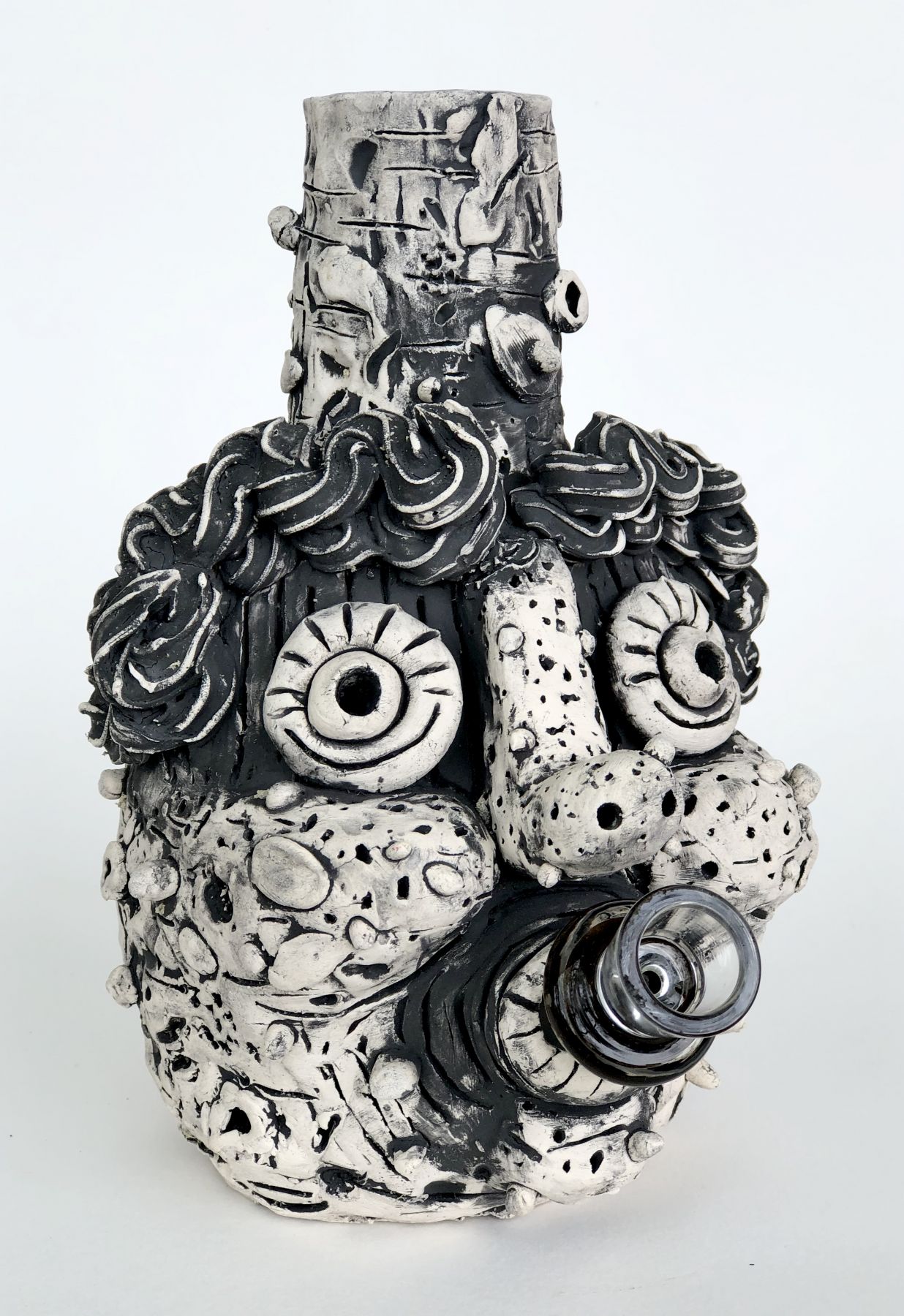 Rebecca Morgan, Essential Bong (side view), ceramic
Rebecca Morgan, Essential Bong (side view), ceramic
WM: Turning away from bucolic scenes, how do you think the proliferation of dispensaries in the city will be reflected in visual culture?
RM: I think like everything else, will get filtered through the “High and low-” the accessibility of potentially buying weed at a bodega or vending machine at one end and an upscale boutique bougie niche experience on the other creates infinite avenues of aesthetics. When finding weed/ the plug becomes pulling up to a dispensary that looks like an Apple store, you know it’s beyond overdue to recuse and reform A LOT a lot of possession/selling sentences and incarceration. I think a lot about how smoking and possessing weed looks different to different social hierarchies- in the same way people think about mobile homes and tricked out tiny homes; what is something that looks different if you are working class and white collar. Visually, it can and will take a lot of shapes, but using those visual cues of who is “socially acceptable” to participate I think will move the discourse along. In the last decade, it is wildly socially acceptable to smoke in a way that I would have been scared to lose teaching jobs before; now making some paintings about smoking weed is LITERALLY my job- innately making those images more front and center, normalized, neutral.
WM: What would you be doing now if you weren’t a professional artist?
RM: I have always told people I would want to have a 9-5, where I clock out and take “nothing home with me”. The concept of separating work from making is so abstract and impossible to conceive as an artist everything is linked, everything is fodder, every experience and feeling is a potential kernel for work, for images, that is the jumpoff. In the most romantic and exhaustingly frustrating way, the lens artists view the world is never “off”- so I always have a sense of “being on the clock.” I’m so curious about how having an occupation that you could flick on and off- leave the desk and forget about it. I think a lot of Americans are in that mindset now- that your job is not a reflection of your personhood. Fuck it, I would work 9-5 at a dispensary. I might do that anyway someday. WM

Josh Niland
is currently the featured staff writer at Archinect in Los Angeles and has contributed to Hyperallergic, Artnet, Architectural Digest, the Boston Phoenix, and other outlets with a focus on artists’ narratives and the psychological underpinnings of the art-making process. He holds a BA in Philosophy from Boston University and is presently looking for publishers for his new book proposal, a work of metafiction depicting post-Covid life in New York City through the lens of thirteen new architectural projects.
view all articles from this author








